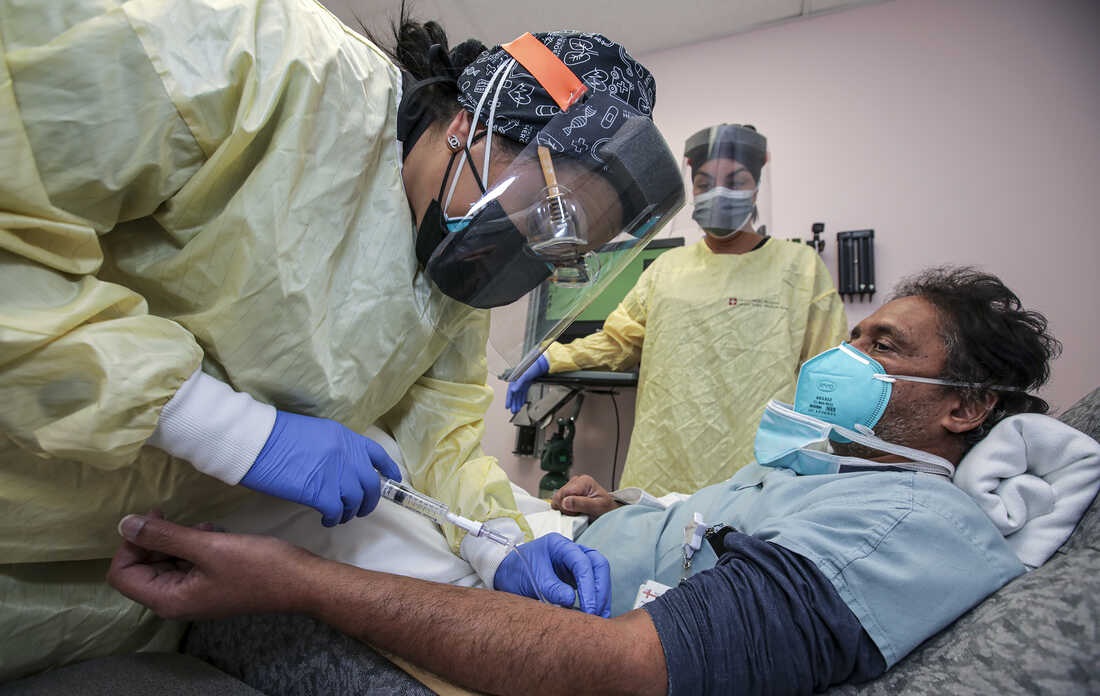The spike (S), envelope (E), membrane (M), and nucleocapsid (N) structural proteins, as well as nonstructural and auxiliary proteins, are all encoded by the SARS-CoV-2 genome. S1 and S2, two components of the spike protein, mediate host cell adhesion and invasion. S1 binds to angiotensin-converting enzyme 2 (ACE2) on the host cell via its receptor-binding domain (RBD), which causes S2 to alter conformation, resulting in virus-host cell membrane fusion and viral entry. Anti-SARS-CoV-2 monoclonal antibodies (mAbs) that target the spike protein have been found to help treat SARS-CoV-2 infection clinically (as discussed below). Some anti-SARS-CoV-2 monoclonal antibodies (mAbs) are effective as post-exposure prophylaxis (PEP) following a potential SARS-CoV-2 exposure in the home and during SARS-CoV-2 epidemics in skilled nursing and assisted living facilities. When administered as pre-exposure prophylaxis, other anti-SARS-CoV-2 mAbs have been found to minimize the risk of infection (PrEP).
COVID-19 is treated by monoclonal antibody (mAb) therapy, commonly known as monoclonal antibody infusion treatment. The purpose of this treatment is to lower viral loads, reduce hospitalizations, and reduce symptom severity.
Monoclonal antibodies are used in this sort of therapy. These antibodies are comparable to those produced naturally by your body in response to infection. Monoclonal antibodies, on the other hand, are mass-produced in a lab and are intended to detect a specific component of this virus: the spike protein on the virus’s outer shell.
These antibodies work by interfering with the virus’s ability to bind to and enter human cells by targeting the spike protein. They help the immune system get a head start until it can mount its defense.
This treatment can be quite helpful, but it is not a substitute for immunization. To interrupt the virus’s cycle of transmission, the community must still stand up and be vaccinated.
Who can benefit from monoclonal antibody therapy?
Individuals who are candidates for monoclonal antibody therapy include those who:
- Are you at an increased risk of developing COVID-19?
- Have a COVID-19 test result but have not yet been admitted to the hospital AND
- Are you 12 years old or older? (and at least 88 pounds)
- Those who have been exposed (and meet the CDC’s close contact criteria)* AND are:
- Not fully vaccinated OR partially vaccinated but immunocompromised AND at least 12 years old (and at least 88 pounds)
Direct exposure isn’t always a need. You are eligible for post-exposure preventative monoclonal antibodies if you match the requirements above and are at high risk of being exposed to an infected individual due to the presence of infection in other individuals in the same institutional setting (for example, nursing homes or jails).
It’s important to realize that post-exposure preventive monoclonal antibodies aren’t a replacement for vaccines. COVID-19 vaccination is strongly recommended for everyone. To know more about vaccines you can click here Covid 19 Vaccine .
Any of the following are considered high risk:
- 65 years old or older
- Overwhelmed (body mass index over 25)
- Pregnancy
- Chronic renal disease (CRD) is a kidney condition that affects men and women alike.
- Diabetes is a disease that affects people (Type 1 and Type 2)
- The immune system is weakened, and you’re on immunosuppressive medication right now.
- Hypertension/cardiovascular disease
- Chronic obstructive pulmonary disease (COPD)
- Sickle cell disease is a type of sickle cell illness.
- Disorders of the nervous system
- Technological dependency in the medical field
Where can I get mAB?
This treatment was made available through hospitals and health systems in Phase 1 of mAB distribution. In Phase 2, which is now underway, mAB will be available for distribution through non-hospital facilities such as long-term care centers; these facilities can either offer mAB themselves or employ an infusion partner if they are capable and willing.
Given the highly limited supply, it is crucial for clinicians to give mAB in compliance with the FDA and CDC’s criteria and protocol to guarantee the maximum effectiveness of the available infusions, as indicated above and contained in the EUA materials.

